Jeep Cherokee (XJ): Stationary glass. Description and operation. Removal and installation
Description and operation
WINDSHIELD SAFETY PRECAUTIONS
DESCRIPTION
WARNING: DO NOT OPERATE THE VEHICLE WITHIN 24 HOURS OF WINDSHIELD INSTALLATION.
IT TAKES AT LEAST 24 HOURS FOR URETHANE ADHESIVE TO CURE. IF IT IS NOT CURED, THE WINDSHIELD MAY NOT PERFORM PROPERLY IN AN ACCIDENT.
URETHANE ADHESIVES ARE APPLIED AS A SYSTEM.
USE GLASS CLEANER, GLASS PREP SOLVENT, GLASS PRIMER, PVC (VINYL) PRIMER AND PINCH WELD (FENCE) PRIMER PROVIDED BY THE ADHESIVE MANUFACTURER. IF NOT, STRUCTURAL INTEGRITY COULD BE COMPROMISED.
DAIMLERCHRYSLER DOES NOT RECOMMEND GLASS ADHESIVE BY BRAND. TECHNICIANS SHOULD REVIEW PRODUCT LABELS AND TECHNICAL DATA SHEETS, AND USE ONLY ADHESIVES THAT THEIR MANUFACTURES WARRANT WILL RESTORE A VEHICLE TO THE REQUIREMENTS OF FMVSS 212. TECHNICIANS SHOULD ALSO INSURE THAT PRIMERS AND CLEANERS ARE COMPATIBLE WITH THE PARTICULAR ADHESIVE USED.
BE SURE TO REFER TO THE URETHANE MANUFACTURER'S DIRECTIONS FOR CURING TIME SPECIFICATIONS, AND DO NOT USE ADHESIVE AFTER ITS EXPIRATION DATE.
VAPORS THAT ARE EMITTED FROM THE URETHANE ADHESIVE OR PRIMER COULD CAUSE PERSONAL INJURY. USE THEM IN A WELL-VENTILATED AREA.
SKIN CONTACT WITH URETHANE ADHESIVE SHOULD BE AVOIDED. PERSONAL INJURY MAY RESULT.
ALWAYS WEAR EYE AND HAND PROTECTION WHEN WORKING WITH GLASS.
CAUTION: Protect all painted and trimmed surfaces from coming in contact with urethane or primers.
Be careful not to damage painted surfaces when removing moldings or cutting urethane around windshield.
OPERATION
The windshield is attached to the window frame with urethane adhesive. The urethane adhesive is applied cold and seals the surface area between the window opening and the glass. The primer adheres the urethane adhesive to the windshield.
It is difficult to salvage a windshield during the removal operation. The windshield is part of the structural support for the roof. The urethane bonding used to secure the windshield to the fence is difficult to cut or clean from any surface. If the moldings are set in urethane, it would also be unlikely they could be salvaged. Before removing the windshield, check the availability of the windshield and moldings from the parts supplier.
Removal and installation
Windshield
The windshield is positioned in the reveal molding and is bonded to the windshield frame with urethane adhesive.
Depending on the circumstances, either one of two windshield glass installation methods can be used:
- The short method.
- The extended method.
The short method is used when the windshield glass is removed intact, and the body opening and the pinchweld flanges do not require repair.
The extended method must be used when the body opening or a flange is damaged. The extended method must also be used when urethane no longer adheres to either the windshield glass or the pinchweld flanges.
REMOVAL
(1) Cover the interior and exterior body surface areas with a protective covering.
(2) Remove the windshield wiper arms and the rearview mirror.
(3) Using a razor knife, slide the blade between the windshield glass and the inboard edge of the reveal molding.
(4) Cut around the interior perimeter of the reveal molding and sever the cap of the reveal molding.
(5) Using a cold knife, cut the urethane around the perimeter of the windshield (Fig. 1).
(6) Remove the windshield glass from the frame.
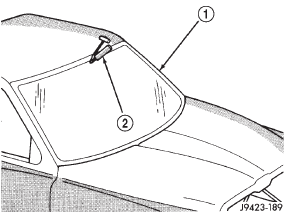
Fig. 1 Cutting Urethane Around Windshield-Typical
1 - WINDSHIELD
2 - COLD KNIFE
INSTALLATION-SHORT METHOD
WARNING: REVIEW ALL WARNINGS AND CAUTIONS IN THIS GROUP BEFORE PRECEDING WITH INSTALLATION.
(1) Trim the urethane from the pinchweld flanges.
Leave a 3 mm (0.1 in.) level base of urethane on the pinchweld flanges.
WARNING: DO NOT USE SOLVENT BASED GLASS CLEANER TO CLEAN WINDSHIELD BEFORE APPLYING GLASS PREP AND PRIMER. POOR ADHESION CAN RESULT.
(2) Clean inside of windshield with ammonia based glass cleaner and lint-free cloth.
(3) Prime outer perimeter of interior side of glass 16 mm (5/8 inch) from edge. Use a wipe-off type urethane primer and wipe glass dry after primer application.
NOTE: The reveal molding has an adhesive applied to the windshield contact surface to help secure the molding to the windshield during the installation procedure.
(4) Apply the molding to the windshield: ² With the molding at room temperature, press the molding onto the windshield corners.
² From corner to corner, work the molding to the center of each side. (Some stretching of the molding may be required during this procedure.) (5) Place the glass on the pinchweld flanges and inspect for gaps in the urethane. Gaps in excess of 3 mm (1/8 inch) must be filled with urethane.
(6) Adjust windshield glass position until it is aligned with the flanges and adhesive.
(7) Using a grease pencil or equivalent, make alignment marks on the glass and body.
(8) Remove replacement windshield from windshield opening.
(9) Position the windshield inside up on a suitable work surface with two padded, wood 10 cm by 10 cm by 50 cm (4 in. by 4 in. by 20 in.) blocks, placed parallel 75 cm (2.5 ft.) apart (Fig. 2).
CAUTION: Avoid spilling or dripping primer on painted surfaces. Clean spills or drips immediately.
The primer will damage the paint if it remains on the surface for any length of time.
(10) If the replacement windshield glass does not have blackout primer:
- Attach a 25 mm (1 in) wide masking tape band around the interior side of the glass 16 mm (5/8 in) from the edge of the glass (Fig. 3).
- Do not attach tape along the bottom of the glass and attach it only to the inside of the glass.
- Clean the 16-mm (5/8-in) wide surface area around the glass with isopropyl alcohol.
- Thoroughly mix and apply glass blackout primer to the 16 mm (5/8 in) surface area around the interior side of the glass (Fig. 4).
- Allow the primer to dry for at least 10-12 minutes.
(11) Apply a small amount of adhesive to the bottom support spacers and attach the support spacers to the bottom of the windshield, 170 mm inboard from the outer windshield edge (Fig. 5).
(12) Cut the urethane adhesive applicator nozzle (Fig. 6).
CAUTION: Be prepared to install the glass immediately after applying the adhesive, as the adhesive will begin to cure in less than 10 minutes.
(13) Apply a continuous, 6-mm (1/4-in) diameter bead of urethane adhesive to the surface area.
(14) Align the glass with the reference marks and position the glass on the pinchweld flanges. Ensure that the windshield glass is correctly seated on the support spacers.
(15) Force the windshield glass inward just enough to wet-out and set the urethane. Use care to avoid excessive squeeze-out of adhesive.
(16) Water test the windshield with a water spray after installation. Do not direct high pressure streams of water directly at urethane. If any leaks are detected, apply urethane as necessary.
(17) If used, remove the masking tape from the inner surface of the glass.
(18) Install all components and clean the vehicle.
(19) Open the vehicle windows to prevent interior pressure while the urethane is curing. If not vented, pressure in the interior of the vehicle may interfere with proper glass bonding.
(20) Install the rearview mirror.
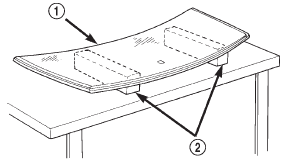
Fig. 2 Work Surface Set up
1 - WINDSHIELD AND MOLDINGS
2 - BLOCKS
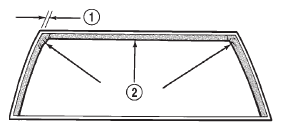
Fig. 3 Masking Tape Location For Blackout Primer
1 - POSITION TAPE 5/8 INCH FROM EDGE OF GLASS
2 - 1-INCH WIDE MASKING TAPE
INSTALLATION-EXTENDED METHOD
WARNING: REVIEW ALL WARNINGS AND CAUTIONS IN THIS GROUP BEFORE PRECEDING WITH INSTALLATION.
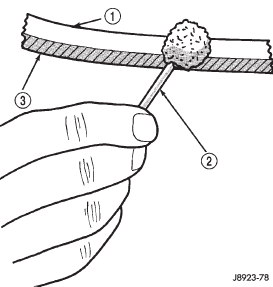
Fig. 4 Blackout Primer Application
1 - APPLY PRIMER TO THIS AREA OF GLASS
2 - BLACKOUT PRIMER APPLICATOR
3 - TAPE
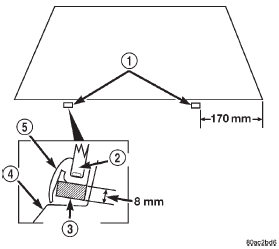
Fig. 5 Windshield Bottom Support Spacers
1 - SUPPORT SPACERS
2 - WINDSHIELD
3 - SUPPORT SPACER
4 - COWL
5 - MOLDING
(1) Remove the all of urethane from all pinchweld flanges.
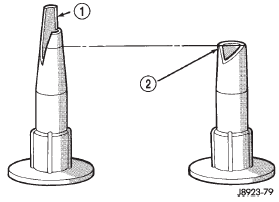
Fig. 6 Applicator Nozzle Preparation
1 - CUT NOZZLE THIS SHAPE FOR EXTENDED PROCEDURE
2 - CUT NOZZLE THIS SHAPE FOR SHORT PROCEDURE
(2) Inspect and repair the windshield opening and pinchweld flanges.
(3) Prime the pinchweld flanges with a urethane base primer. However, if the flange is color-coated with paint, prime the flanges with a paint finish primer. This is important because urethane adhesive will not adhere to all color-coat paints. Allow primer sufficient time to dry.
NOTE: The reveal molding has an adhesive applied to the windshield contact surface to help secure the molding to the windshield during the installation procedure.
(4) Apply the reveal molding to the windshield: ² With the molding at room temperature, press the molding onto the windshield corners.
² From corner to corner, work the molding to the center of each side. (Some stretching of the molding may be required during this procedure).
(5) Install and inspect the fit of the windshield on the pinchweld flanges as follows:
- Position windshield until it is aligned within windshield opening.
- Measure the gap between the pinchweld flanges and glass around perimeter of the glass and flange.
- The reveal molding should equally cover the A-Pillars on both sides.
- The flanges should also extend above the glass edge equally around the perimeter of the opening.
(6) If the pinchweld flanges require repair, remove the windshield glass and straighten, align, or repair the flange(s) as necessary.
(7) Position the windshield in the opening and inspect the windshield fit again. Mark the windshield final position on the glass and body with a wax pencil (or use masking tape). The marks (or masking tape) will be used for installation alignment reference.
(8) If the replacement windshield does not have blackout primer:
- Attach a 25-mm (1-in) wide masking tape band around the interior side of glass 16 mm (5/8 in) from edge of glass (Fig. 3).
- Do not attach tape along the bottom of the glass and attach only to the inside of glass.
- Thoroughly mix and apply blackout primer to the 16 mm (5/8 in) surface area around the interior side of the glass (Fig. 4).
- Allow the primer to dry for at least 10-12 minutes.
(9) Apply a small amount of adhesive to the bottom support spacers and attach the support spacers to the bottom of the windshield, 170 mm inboard from the outer windshield edge (Fig. 5).
(10) Cut the urethane applicator nozzle (Fig. 6).
(11) Apply a continuous bead of urethane to the surface area with blackout primer on the interior side of glass. The bead should be 9-mm (3/8-in) wide by 12.7-mm (1/2-in) deep for best results.
CAUTION: Be prepared to install the glass immediately after applying the adhesive, as the adhesive will begin to cure in less than 10 minutes.
(12) Align the windshield with the wax pencil installation alignment reference marks (or the tape strips). Position the windshield on pinchweld flanges and spacers.
(13) Force the windshield inward just enough to wet-out and set the urethane. Use care to avoid excessive squeeze-out of adhesive.
(14) Water test the windshield with a water spray after installation. Do not direct high pressure streams of water directly at the urethane. If any leaks are detected, apply urethane as necessary.
(15) If used, remove the masking tape from the inner surface of glass.
(16) Install all components and clean the vehicle.
If necessary, refer to the installation procedures.
(17) Open the vehicle windows to prevent interior pressure while the urethane adhesive is curing. If not vented, pressure in the interior of vehicle will interfere with glass bonding.
(18) Install the rearview mirror on the bracket.
Rear door stationary window glass
REMOVAL
The rear door stationary window glass is bonded to the division bar and is serviced as an assembly.
(1) Lower the window glass.
(2) Remove the inner and outer beltline weatherstrip.
(3) Remove the trim panel and waterdam from door inner panel.
(4) Remove the screws attaching the division bar/ glass to the door (Fig. 7).
(5) Tilt the division bar/glass forward and remove it from the door.
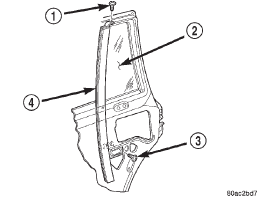
Fig. 7 Division Bar/Stationary Glass
1 - UPPER SCREW
2 - GLASS
3 - LOWER SCREW
4 - DIVISION BAR
INSTALLATION
(1) Position the division bar/glass in the door.
(2) Install the screws attaching the division bar/ glass to the door. Finger tighten the screws.
(3) Tighten the upper screw to 6 N·m (5 ft-lbs) torque.
(4) Tighten the lower screw to 6 N·m (5 ft-lbs) torque.
(5) Install the beltline weatherstrip.
(6) Install the door waterdam and trim panel.
Rear quarter window glass
REMOVAL
(1) If equipped, remove the quarter window reveal molding (Fig. 8).
(2) Remove the quarter window interior trim covers.
(3) Separate the weatherstrip seal lip from the window opening flanges. Use a pry tool and carefully push the window glass and seal outward.
(4) Remove the weatherstrip seal and window glass from window opening.
(5) Remove the weatherstrip seal from the window glass.
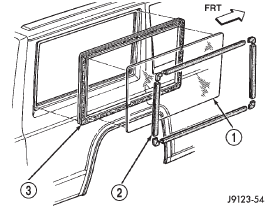
Fig. 8 Quarter Window Reveal Molding, Glass and Seal
1 - GLASS
2 - REVEAL MOULDING
3 - WEATHERSTRIP SEAL
INSTALLATION
(1) Clean the original sealant from the weatherstrip channels and window opening flanges.
(2) Apply a 4-mm (1/6-in) diameter bead of sealant to the window channel in the weatherstrip seal.
(3) Install the weatherstrip on the window glass.
Install the seal installation cord in the window opening flange channel (Fig. 9) as follows:
- Moisten a length of 6-mm (1/4-in) diameter cord with a soap and water solution.
- Ensure that the cord is long enough to go all the way around the perimeter of the weatherstrip.
- Insert the cord into the window opening flange channel in the weatherstrip seal.
(4) Apply a 6-mm (1/4-in) diameter bead of sealant to the window opening flanges.
(5) For two-door vehicles, apply a 3-mm (1/8-in) diameter bead of sealant at the quarter panel applique and liftgate pillar seam.
(6) Position the quarter window glass and the weatherstrip seal in the window opening (Fig. 10) with the free ends of the cord inside the vehicle (Fig.
11).
(7) Pull on each end of the cord to pull the weatherstrip seal channel lip over the window opening flanges.
(8) Test the vent window for water leaks.
(9) Install the interior trim cover.
(10) If equipped, install the quarter window reveal molding.
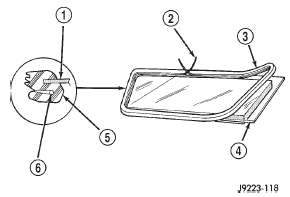
Fig. 9 Weatherstrip Seal and Cord Installation
1 - WINDOW GLASS
2 - INSTALLATION CORD END
3 - WEATHERSTRIP SEAL
4 - WINDOW GLASS
5 - WEATHERSTRIP SEAL
6 - INSTALLATION CORD
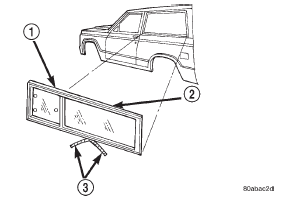
Fig. 10 Quarter Window With Vent
1 - QUARTER WINDOW W/VENT
2 - WEATHERSTRIP SEAL
3 - INSTALLATION CORD
Liftgate glass
REMOVAL
(1) Open liftgate.
(2) Remove liftgate trim panel.
(3) Disconnect heated backlite (HBL) connector.
(4) Remove wiper arm.
(5) Remove CHMSL lens.
(6) Using a razor knife, slide the blade between the liftgate glass and the inboard edge of the reveal molding.
(7) Cut around the interior perimeter of the reveal molding and severe the cap of the reveal molding.
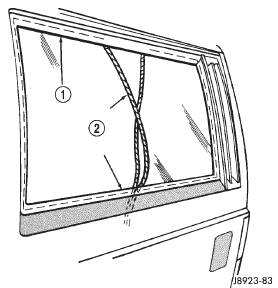
Fig. 11 Quarter Window Glass and Seal Installation
1 - WEATHERSTRIP
2 - 1/4-INCH DIAMETER CORD (POSITION IN WEATHERSTRIP GLASS CHANNEL)
(8) Using a cold knife, cut urethane bonding from around liftgate glass. A pneumatic cutting device can be used if available.
(9) Separate glass from Liftgate.
INSTALLATION
CAUTION: Open a window before installing glass.
This will avoid pressurizing the passenger compartment.
If a door or liftgate is slammed before urethane is cured, water leaks can result.
(1) Trim the urethane from the liftgate glass opening flanges. Leave a 3 mm (0.1 in.) level base of urethane on the flanges.
(2) Starting in the corners, press reveal molding onto glass.
(3) Place replacement glass into liftgate opening and position glass in the center of the opening against flange.
(4) Verify the glass lays evenly against the fence at the sides, top and bottom. If not, the flange must be formed to the shape of the new glass.
(5) Using a grease pencil or equivalent, make references marks on the glass and body.
(6) Remove replacement glass from liftgate opening.
(7) Position the glass inside up on a suitable work surface.
WARNING: DO NOT USE SOLVENT BASED GLASS CLEANER TO CLEAN WINDSHIELD BEFORE APPLYING GLASS PREP AND PRIMER. POOR ADHESION CAN RESULT.
(8) Clean inside of glass with Mopar Glass Cleaner and lint-free cloth.
(9) Apply PVC (vinyl) primer 25 mm (1 in.) wide around edge of glass. Wipe with clean/dry lint-free cloth.
(10) If necessary, apply fence primer around edge of fence. Allow at least eighteen minutes drying time.
(11) Apply a 10 mm (0.4 in.) bead of urethane around glass border.
(12) Position glass into liftgate opening and reference marks.
(13) Push the glass inward until the reveal molding is seated onto the liftgate frame. Use care to avoid excessive squeeze-out of adhesive.
(14) Open windows to prevent pressure build-up while the urethane is curing.
(15) Apply 150 mm (6 in.) lengths of 50 mm (2 in.) masking tape spaced 250 mm (10 in.) apart to hold glass in place until urethane cures.
(16) Install the wiper arm.
(17) Install CHMSL lens.
(18) Connect heated backlite (HBL) connector.
(19) After urethane has cured, remove tape strips and water test to verify repair.
(20) Install liftgate trim panel.
Other materials:
General information
Introduction
Windshield wiper and washer systems are standard
factory-installed equipment on this model. A
rear wiper and washer system is optional factory-installed
equipment. Following is general information
about the available wiper and washer systems for
this vehicle. Refer to 8W-53 - Wiper ...


